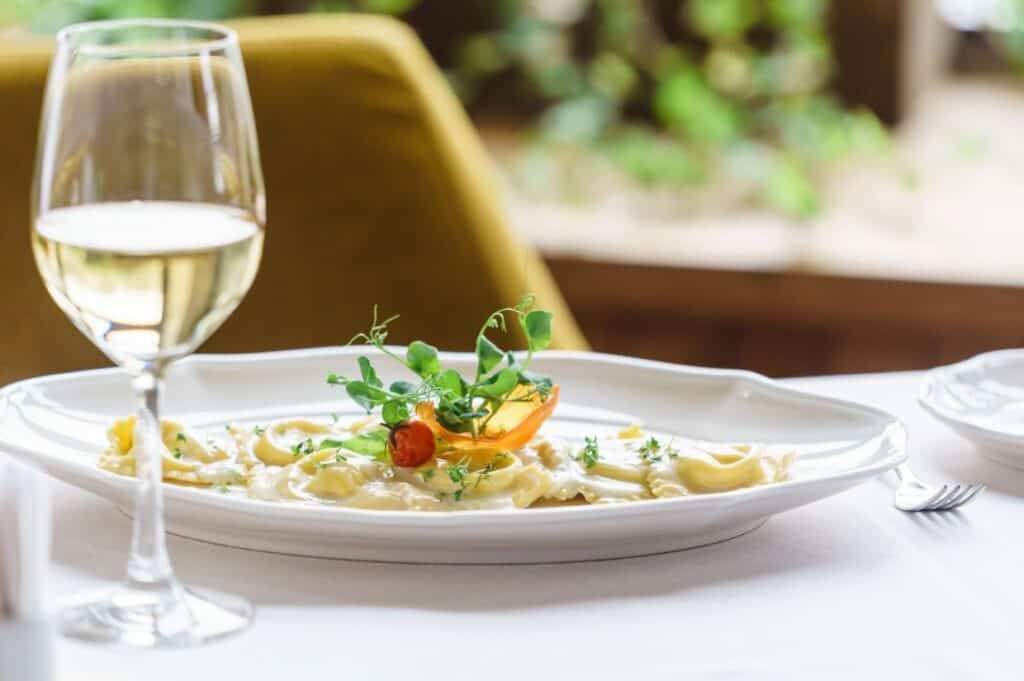Let’s face it — picking wine for a dinner party often involves a last-minute dash to the store. It’s easy to get caught up in planning the guest list, food menu and decor, pushing the wine decision to the bottom of your list. While wine pairing can feel overwhelming, the secret is to keep it simple and focus on creating a great experience for everyone around your table.

Let the menu lead the way
Your menu is the foundation for choosing the right wine. The food you serve sets the tone, and the wine should complement those flavors without stealing the show. Think of wine as another ingredient in your meal rather than a separate entity.
Just as you wouldn’t serve an overpowering sauce with a delicate fish, you want your wine to enhance rather than compete with your food. Understanding a few basic principles matters more than memorizing rigid rules.
Weight and intensity matter
Start with the weight and intensity of both the wine and the dish. Light dishes generally pair well with lighter wines, while heartier foods call for more robust options. A crisp pinot grigio works well with a summer salad or light seafood, while a bold cabernet sauvignon stands up nicely to a grilled steak.
Many hosts focus solely on whether they’re serving red or white meat, but the sauce and preparation method matter as much as the main protein. Chicken breast in a light lemon sauce pairs differently than chicken thighs in a rich mushroom cream sauce. The first might call for a light white wine like Chablis, while the latter could stand up to a light-bodied red like pinot noir.
Embrace acidity
Acidity in wine acts like a squeeze of lemon on your plate. It brightens flavors, cuts through richness and cleanses the palate. Wines with high acidity, like sauvignon blanc or riesling, are especially good with fatty foods or creamy sauces. Imagine a rich pasta dish — a crisp sauvignon blanc will balance that richness and refresh your taste buds.
High-acid red wines like pinot noir or Chianti can cut through the richness of creamy sauces or cheese. They’re also great companions to tomato-based dishes, where the wine’s acidity mirrors the brightness of the sauce.

Think in terms of flavor pairings
This one’s pretty straightforward. Try a wine with similar fruit notes if your dish has fruity flavors. A riesling with hints of apple would be delightful with an apple tart. Earthy wines, like some pinot noirs, pair well with mushrooms or roasted vegetables.
From heat to sweet
When it comes to spicy foods, first determine your goal: Do you want to tame or enhance the heat? If you want to boost the spiciness, go for a bold, fruity red like a syrah or grenache. Think of fruit instead of tannins, as the tannins will clash with the spice. South American malbec or California zinfandel can also work well with some spicy dishes.
Pair the food with an off-dry riesling or gewurztraminer to mellow the heat. Full-bodied rose or orange wines are other suggestions that can stand up to the heat.
For your dessert course, follow the simple rule that your wine should be sweeter than your food. A dry wine paired with a sweet dessert will taste bitter and thin. A ruby port subtly enhances a decadent chocolate cake, while a fruit tart works well with moscato or a late-harvest riesling.
Beyond the basics
Once you’ve grasped the basics, you can explore more nuanced approaches to wine pairing, considering regional influences, textural elements and even the art of contrasting flavors.
Regional wines
Regional pairings often work well together because they’ve evolved alongside each other over centuries. Italian Chianti with tomato-based pasta, Spanish albarino with seafood or French Bordeaux with lamb are classic combinations for good reason. These time-tested pairings can serve as reliable guides when planning your menu.
What is full-bodied anyway
The texture of wine can significantly affect the overall dining experience. Texture refers to consistency or thickness, also known as viscosity. Full-bodied wines have a thicker consistency on the palate than light-bodied wines. This is also related to the alcohol content: Lower viscosity means less alcohol by volume or ABV, while a thicker, full-bodied wine has a higher ABV.
A buttery chardonnay is a match made in heaven with a creamy risotto, while a tannic cabernet sauvignon pairs perfectly with the rich texture of a grilled steak. Texture, like flavor, should serve as a complement.
The art of contrast
You’ve learned about pairing lighter wines with lighter food, but the converse is that the most exciting pairings often arise from contrasting flavors. A sweet dessert wine like Sauternes can cut through the saltiness of blue cheese, creating a nice balance. Similarly, a dry sparkling wine is the ultimate palate cleanser after a rich meal, preparing you for the next course.
Planning your dinner party
When choosing the perfect wines for your party, it’s also important to consider your guests’ preferences. While pairing guidelines can point you in the right direction, breaking the rules is okay. If you know someone who doesn’t enjoy red wine, have a white option ready.
“Wine pairing for a dinner party doesn’t have to be complicated, and it’s an easy way to make the meal feel extra special. I like to offer two or three options — a crisp white, a smooth red and maybe something sparkling or rose — so there’s plenty for guests to choose from. I aim to balance what’s on the menu with my guests’ tastes. For instance, if I’m serving a rich mushroom risotto, a pinot noir complements it with its earthy notes, but for guests who prefer white wine, a lightly oaked chardonnay works beautifully, too. This way, the pairings enhance the meal while making sure everyone has something they’ll enjoy.”
— Kristin King, Dizzy Busy and Hungry
Temperature matters
Wine temperature can make or break the experience. To bring out their flavors, serve reds slightly cool — about 60 to 65 degrees. Whites and other lighter-colored wines should be chilled but not too cold, around 50 to 55 degrees. Sparkling wines are best at a brisk 45 degrees. If you’re pressed for time, a quick chill in the freezer can work wonders.
Best tip
Don’t shop for wine in the grocery store. It’s usually more expensive than a liquor store or specialty wine shop. A wine shop is your best option since the staff is trained and familiar with many different wines. They are happy to help you select the best wines for your party.

It’s all about the experience
The most important thing to remember is that wine pairing shouldn’t cause stress. While guidelines can help create memorable combinations, there’s no single correct answer. Wine brings pleasure and connection to a gathering. If your guests enjoy themselves and the conversation flows, you’ve created a successful pairing, regardless of what’s in their glasses.
Lucy Brewer is a professional writer and fourth-generation Southern cook who founded Southern Food and Fun. She’s passionate about preserving classic Southern recipes while creating easy, crowd-pleasing dishes for the modern home cook.